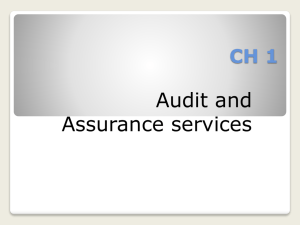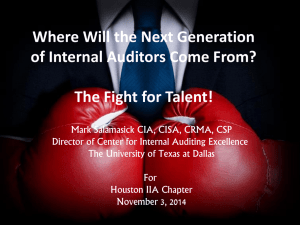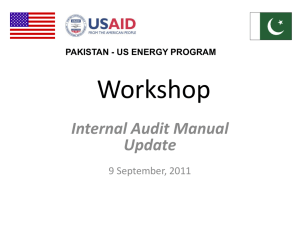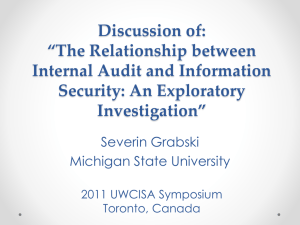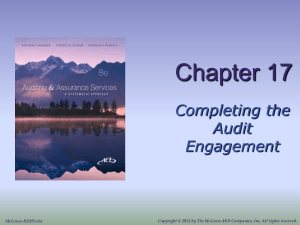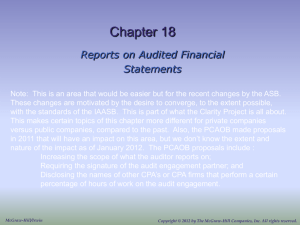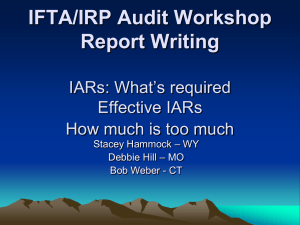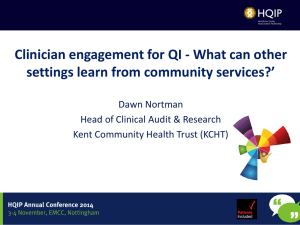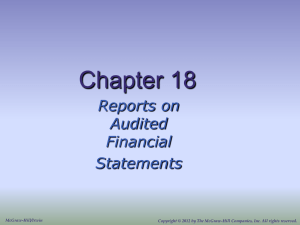Chapter 2 - Lorsbach`s Auditing Resource
advertisement
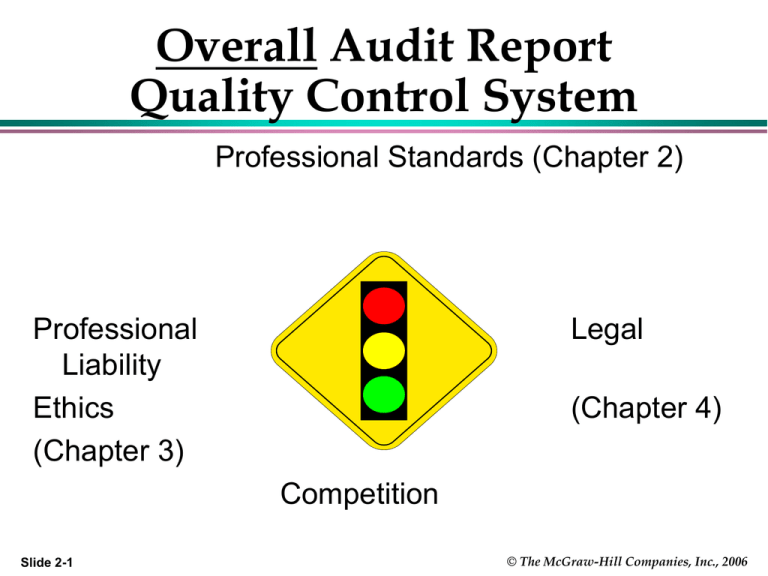
Overall Audit Report Quality Control System Professional Standards (Chapter 2) Professional Liability Ethics (Chapter 3) Legal (Chapter 4) Competition Slide 2-1 © The McGraw-Hill Companies, Inc., 2006 Sources of Professional Standards & Rules Public Company Accounting Oversight Board • Auditing, Attestation, Quality Control, Independence, and Ethical Standards for Audits of Public (issuer)Companies American Institute of Certified Public Accountants • Auditing, Attestation, Quality Control, Independence, Ethical, and Accounting and Review Standards (and more) for Engagements at Nonpublic Companies. State Boards of Accountancy • License CPAs and CPA firms to practice in their jurisdictions. Slide 2-2 © The McGraw-Hill Companies, Inc., 2006 AICPA Auditing Standards There are 5 Broad Principles that Define Generally Accepted Auditing Standards (GAAS). (Minimum Expectations) Statements on Auditing Standards (SAS) are Issued to provide detail to the Broad GAAS. Interpretations are also issued. Codified in AICPA’s Professional Standards Section AU. SASs are Frequently Issued to Better Satisfy F.S. User Expectations. Slide 2-3 © The McGraw-Hill Companies, Inc., 2006 Underlying Principles 1. Purpose of an audit 2. Premise of an audit 3. Personal responsibilities of the auditor 4. Auditor actions in performing the audit 5. Reporting results of an audit Slide 2-4 © The McGraw-Hill Companies, Inc., 2006 Underlying Principles (con’t) Purpose of an Audit—Provide an opinion on whether financial statements are materially in accordance with the applicable financial reporting framework. The framework is ordinarily GAAP. The applicable framework corresponds to the “suitable criteria” of an attest engagement. Slide 2-5 © The McGraw-Hill Companies, Inc., 2006 Underlying Principles (con’t) Premise of an Audit—Management (and those charged with governance) have responsibility to: Prepare fairly presented financial statements in accordance with applicable financial reporting framework. Design, implement and maintain internal controls that achieve the above with F.S. that are free of material misstatements. Provide the auditor with needed/requested information and unrestricted access to those in the entity. Slide 2-6 © The McGraw-Hill Companies, Inc., 2006 Underlying Principles (con’t) Personal Responsibility of the Auditor (team) Have appropriate competence & capabilities to perform audit in accordance with standards, including maintaining professional skepticism and exercising professional judgment throughout the audit. Professional Skepticism—A questioning mind and a critical assessment of audit evidence. Slide 2-7 © The McGraw-Hill Companies, Inc., 2006 Underlying Principles (con’t) Auditor Actions in Performing the Audit To express an opinion, the auditor obtains reasonable assurance about whether financial statements are free from material error or fraud. To obtain reasonable assurance, the auditor: Plans the work and properly supervises assistants. Determines appropriate materiality levels. Identifies & assesses risks of a material misstatement based on an understanding of the entity & its environment, including internal controls. Obtains sufficient & appropriate audit evidence. Slide 2-8 © The McGraw-Hill Companies, Inc., 2006 Underlying Principles (con’t) Auditor Actions in Performing the Audit The auditor is unable to obtain absolute assurance due to: – Nature of financial reporting. – Nature of audit procedures. – Need to conduct audit within a reasonable period of time. Slide 2-9 © The McGraw-Hill Companies, Inc., 2006 Underlying Principles (con’t) Reporting the Results of an Audit—Express in a written report an opinion on F.S. (or statement that opinion cannot be expressed). » The opinion is on whether the financial statements are in accordance, in all material respects, with the applicable financial reporting framework. Slide 2-10 © The McGraw-Hill Companies, Inc., 2006 PCAOB GAAS General Standards 1. The audit must be performed by a person or persons having adequate technical training and proficiency as an auditor. 2. In all matters relating to the assignment, an independence in mental attitude is to be maintained by the auditor or auditors. 3. Due professional care is to be exercised in the performance of the audit and the preparation of the report. Slide 2-11 © The McGraw-Hill Companies, Inc., 2006 PCAOB GAAS Standards of Field Work 1. The work is to be adequately planned and assistants, if any, are to be properly supervise. 2. A sufficient understanding of internal control is to be obtained to plan the audit and to determine the nature, timing, and extent of tests to be performed. Slide 2-12 © The McGraw-Hill Companies, Inc., 2006 PCAOB GAAS Standards of Field Work (con’t) 3. Sufficient competent evidential matter is to be obtained through inspection, observation, inquiries, and confirmations to afford a reasonable basis for an opinion regarding the financial statements under audit. Slide 2-13 © The McGraw-Hill Companies, Inc., 2006 PCAOB GAAS Standards of Reporting 1. The report shall state whether the financial statements are presented in accordance with generally accepted accounting principles (GAAP). 2. The report shall identify those circumstances in which such principles have not been consistently observed in the current period in relation to the preceding period. (Exception only) 3. Informative disclosures in the financial statements are to be regarded as reasonably adequate unless otherwise stated in the report. (Exception only) Slide 2-14 © The McGraw-Hill Companies, Inc., 2006 PCAOB GAAS Standards of Reporting (con’t) 4. The report shall contain either (1) an expression of opinion regarding the financial statements, taken as a whole, or (2) an assertion to the effect that an opinion cannot be expressed. When an overall opinion cannot be expressed, the reasons therefore should be stated. In all cases where an auditor’s name is associated with financial statements, the report should contain a clear-cut indication of the character of the auditor’s work, if any, and the degree of responsibility the auditor is taking. Slide 2-15 © The McGraw-Hill Companies, Inc., 2006 AICPA Terminology Defined Responsibility Level Unconditional Responsibility Meaning Auditor must fulfill responsibilities Words Used to Indicate Responsibility “Must” “Is required” (PCAOB only) “Shall” (PCAOB only) Presumptively Mandatory Auditor must comply with requirements unless auditor demonstrates and documents that alternative actions were sufficient to achieve the objectives of the standards. “Should” Responsibility to Consider Auditor should consider; whether the auditor complies with the requirements depends on the exercise of professional judgment in the circumstances. “May” “Might” “Could” (Plus other phrases indicating a responsibility to consider.) The GAAS (AICPA) Hierarchy Category 1. Standards 2. Interpretative Publications 3. Other Auditing Publications Status Audit Guidance Auditors should apply at the levels on the previous slide in accordance with the pertinent auditing standards. Recommendations on the application of the SASs. If not followed, the auditors should be prepared to explain how they complied with the SAS provisions addressed. No authoritative status, but may help the auditor understand and apply the standards. The 5 principles SASs (AU and AU-C) Other standards for PCAOB, govt. audits, etc. Appendices to SASs Interpretation of SASs Auditing guidance in AICPA Audit and Accounting Guides AICPA auditing Statements of Position Auditing articles Continuing education programs Textbooks Guidebooks Audit programs Checklists Unique PCAOB Auditing Standards AS 1 References in Auditors’ Reports to the Standards of the Public Company Accounting Oversight Board AS 2 Superseded by AS 5 AS 3 Audit Documentation AS 4 Reporting on Whether a Previously Reported Material Weakness Continues to Exist AS 5 An Audit of Internal Control Over Financial Reporting That Is Integrated with An Audit of Financial Statements AS 6 Evaluating Consistency of Financial Statements AS 7 Engagement Quality Review AS 8 Audit Risk AS 9 Audit Planning Slide 2-18 © The McGraw-Hill Companies, Inc., 2006 Unique PCAOB Auditing Standards (con’t) AS 10 Supervision of the Audit Engagement AS 11 Consideration of Materiality in Planning and Performing an Audit AS 12 Identifying and Assessing Risks of Material Misstatement AS 13 The Auditor's Responses to the Risks of Material Misstatement AS 14 Evaluating Audit Results AS 15 Audit Evidence AS 16 Communications with Audit Committees Slide 2-19 © The McGraw-Hill Companies, Inc., 2006 The Standard Auditors’ Report (Non-Public Client) Title Addressee Content Sections (paragraphs) Introductory (“We have audited”) Management’s responsibility Auditor’s Responsibility Opinion Paragraph Signature (firm name) City and state of office issuing audit report Date (Last Day of Field Work or . . .) Slide 2-20 © The McGraw-Hill Companies, Inc., 2006 The Standard Auditors’ Report Introductory Paragraph We have audited the accompanying consolidated balance sheets of ABC Company and its subsidiaries, as of December 31, 20X1 and 20X0, and the related consolidated statements of income, retained earnings, and cash flows for the years then ended. Slide 2-21 © The McGraw-Hill Companies, Inc., 2006 The Standard Auditors’ Report Mgmt Responsibility Paragraph Management is responsible for the preparation and fair presentation of these consolidated financial statements in accordance with accounting principles generally accepted in the United States of America; this includes the design, implementation, and maintenance of internal control relevant to the preparation and fair presentation of consolidated financial statements that are free from material misstatement, whether due to fraud or error. Slide 2-22 © The McGraw-Hill Companies, Inc., 2006 The Standard Auditors’ Report Auditors’ Responsibility Paragraphs Our responsibility is to express an opinion on these consolidated financial statements based on our audits. We conducted our audits in accordance with auditing standards generally accepted in the United States of America. Those standards require that we plan and perform the audit to obtain reasonable assurance about whether the consolidated financial statements are free of material misstatement. Slide 2-23 © The McGraw-Hill Companies, Inc., 2006 What is Reasonable Assurance? •High Level of Assurance, But Not Absolute •Audit Evidence More Likely Persuasive Rather than Convincing or Conclusive: Nature of Audit Testing - Not 100% and Involves Use of Professional Judgment Nature of Audit Evidence (e.g., Accounting Estimates) Characteristic of Fraud, Including Concealment Slide 2-24 © The McGraw-Hill Companies, Inc., 2006 The Standard Auditors’ Report Auditors’ Responsibility Paragraphs (con’t) An audit involves performing procedures to obtain audit evidence about the amounts and disclosures in the consolidated financial statements. The procedures selected depend on the auditor's judgment, including the assessment of the risks of material misstatement of the consolidated financial statements, whether due to fraud or error. In making those risk assessments, the auditor considers internal control relevant to the entity's preparation and fair presentation of the consolidated financial statements in order to design audit procedures that are appropriate in the circumstances, but not for the purpose of expressing an opinion on the effectiveness of the entity's internal control. Slide 2-25 © The McGraw-Hill Companies, Inc., 2006 The Standard Auditors’ Report Auditors’ Responsibility Paragraphs (con’t) An audit also includes evaluating the appropriateness of accounting policies used and the reasonableness of significant accounting estimates made by management, as well as evaluating the overall presentation of the consolidated financial statements. We believe that the audit evidence we have obtained is sufficient and appropriate to provide a basis for our audit opinion. Slide 2-26 © The McGraw-Hill Companies, Inc., 2006 The Standard Auditors’ Report Opinion Paragraph In our opinion, the consolidated financial statements referred to above present fairly, in all material respects, the financial position of ABC Company and its subsidiaries as of December 31, 20X1 and 20X0, and the results of their operations and their cash flows for the years then ended in accordance with accounting principles generally accepted in the United States of America. Slide 2-27 © The McGraw-Hill Companies, Inc., 2006 Audit Report – Public Company • Title is “Report of Registered Independent Public Accounting Firm” rather than “Independent Auditors’ Report”. • Refers to PCAOB standards rather than GAAS. • Includes a that refers to report on internal control. • Includes City and State (or Country) of audit firm. Slide 2-28 © The McGraw-Hill Companies, Inc., 2006 Old GAAP Hierarchy 1. Authoritative Body Pronouncements 2. Pronouncements of Bodies Composed of Expert Accountants, That Are Exposed for Public Comment 3. Pronouncements of Bodies of Expert Accountants That Are Not Exposed for Public Comment 4. Widely Recognized Practices and Pronouncements 5. Other Slide 2-29 Accounting Literature (e.g., Text Books) © The McGraw-Hill Companies, Inc., 2006 Current GAAP Hierarchy (Non-Gov’t) • Authoritative: FASB Accounting Standards Codification (ASC) plus Rules and Interpretive releases of the SEC under authority of federal securities laws for SEC registrants. • ASC updated via Accounting Standards Updates (ASU). • Non-Authoritative: All other sources. Slide 2-30 © The McGraw-Hill Companies, Inc., 2006 Errors/Mistakes vs. Fraud In the Auditing Standards: Errors = Unintentional F.S. Misstatements or Omissions of Amounts or Disclosures Fraud = Intentional Acts That Cause a F.S. Misstatement Which Result From: 1. Fraudulent Financial Reporting or 2. Theft of Assets (also called Defalcation) Source: SAS 99, 113 Slide 2-31 © The McGraw-Hill Companies, Inc., 2006 Auditor Responsibility for the Detection of Errors and Fraud Assess the risk of errors and fraud that may cause the financial statements to contain a material misstatement. Obtain information to assess the inherent risks and fraud risks: Information about the company and its environment Discussion among audit team members Inquiries of management and others Planning analytical procedures, including those involving revenue Based on that assessment, plan and perform the audit to obtain reasonable assurance that material misstatements, whether caused by errors or fraud, will be detected (including specific steps required by SAS 99). Exercise due care in planning, performing and evaluating the results of audit procedures, and the proper degree of professional skepticism to achieve reasonable assurance that material misstatements due to error or fraud will be detected. Slide 2-32 © The McGraw-Hill Companies, Inc., 2006 Professional Skepticism? • Toughest attribute for some auditors. • Basically means that we must have support for our conclusions that is: 1. Convincing (consider competency/reliability) 2. Corroborated (consistent evidence) 3. Verified or Tested by the auditor Slide 2-33 © The McGraw-Hill Companies, Inc., 2006 Auditor Responsibility for the Detection of Noncompliances w/ Laws & Regulations For those laws & regulations that are generally recognized as having a direct and material effect on financial statement amounts & disclosures--same as for errors & fraud: • Assess the risk of illegal acts that may have caused the financial statements to contain a material misstatement. • Based on that assessment, plan and perform the audit to obtain reasonable assurance that misstatements caused by illegal acts will be detected if direct & material impact. • Exercise due care in planning, performing and evaluating the results of audit procedures, and the proper degree of professional skepticism to achieve reasonable assurance that material misstatements due to illegal acts will be detected. Slide 2-34 © The McGraw-Hill Companies, Inc., 2006 Auditor Responsibility for the Detection of Noncompliances w/ Laws & Regulations Examples of laws & regulations that are generally recognized as having a direct and material effect on financial statement amounts & disclosures are Laws & regulations related to: Taxes Pensions Form or content of F.S. (SEC) Industry-specific reporting Contracts/grants with the government that could affect revenue or expense recognition. Slide 2-35 © The McGraw-Hill Companies, Inc., 2006 Auditor Responsibility for the Detection of Noncompliances w/ Laws & Regulations (con’t) For those laws & regulations that are NOT generally recognized as having a direct effect, but could still have a material effect, on financial statements (generally disclosures): Inquire of management and, when appropriate, those charged with governance about whether the entity is in compliance with such laws and regulations. Inspect correspondence, if any, with the relevant licensing or regulatory authorities. Examples: Related solely to operations (anti-trust) or fines/penalties that could be levied, terms of a license, regulatory solvency requirements, workplace or environmental regs. Slide 2-36 © The McGraw-Hill Companies, Inc., 2006 Auditor Responsibility – Other Than Detection For immaterial fraud and noncompliances: Be aware of possible occurrence. If information comes to the auditor’s attention, apply audit procedures directed at determining whether fraud or noncompliance has occurred and its potential impact on the financial statements. (But, an audit does not provide assurance that such acts will be detected.) Inform client top management and/or the audit committee (top mgmt involved or material). Slide 2-37 © The McGraw-Hill Companies, Inc., 2006 Reporting Fraud & Law /Reg Noncompliances Report ANY fraud or noncompliances found by the auditor to client top management (at least one level above) and/or to those charged with governance. Report to those charged with governance if material, top management involved, intentional, but not if inconsequential. No responsibility to report to law enforcement. If CPA is fired or resigns, there is reporting of the auditor change & reason for the change to SEC for SECregulated clients. Under Gov’t Auditing Stds (esp. Single Audit Act), there may be reporting to certain government officials. Slide 2-38 © The McGraw-Hill Companies, Inc., 2006 AICPA Quality Control Standards CPA firms must establish a system of quality control designed to provide the firm with reasonable assurance that the firm and its personnel comply with professional standards and applicable regulatory and legal requirements, and that the firm or engagement partners issue reports that are appropriate in the circumstances. Applicable to the firm’s audit, attestation and accounting practice and will vary based on firm size and complexities. Slide 2-39 © The McGraw-Hill Companies, Inc., 2006 AICPA Elements of Quality Control 1. Leadership Responsibilities for quality within the firm (the "tone at the top") 2. Relevant Ethical Requirements 3. Acceptance and Continuance of Client Relationships and specific engagements 4. Human Resources 5. Engagement Performance 6. Monitoring Slide 2-40 © The McGraw-Hill Companies, Inc., 2006 2-13 Regulation of the Public Accounting Profession—Public Companies • Public Company Accounting Oversight Board and the SEC Registration of public accounting firms that audit public companies. Establish or adopt auditing, quality control, ethics, independence and other standards for auditors of public companies. Conduct inspections of registered public accounting firms. Slide 2-41 © The McGraw-Hill Companies, Inc., 2006 2-14 Regulation of the Public Accounting Profession—Nonpublic Companies American Institute of Certified Public Accountants Peer review/inspection program Ethics investigations State Boards of Accountancy Registration of all CPAs and CPA firms Investigates complaints against CPAs Investigates ethics violations Slide 2-42 © The McGraw-Hill Companies, Inc., 2006 International Accounting Standards International Financial Reporting Standards (IFRS) Developed by International Accounting Standards Board (IASB). SEC accepts IFRS for foreign companies that issue securities in US markets. Topic added to U.S. CPA Exam in 2011. Slide 2-43 © The McGraw-Hill Companies, Inc., 2006 International Audit Report • Contains expanded description of management’s responsibility. • Contains an enhanced explanation of the audit process. • May state “present fairly, in all material respects” or “give a true and fair view”. • Report may indicate that the financial statements comply with the provisions of the country’s relevant statutes or laws. • May be signed using the personal name of the auditor or the audit firm or both. Slide 2-44 © The McGraw-Hill Companies, Inc., 2006
